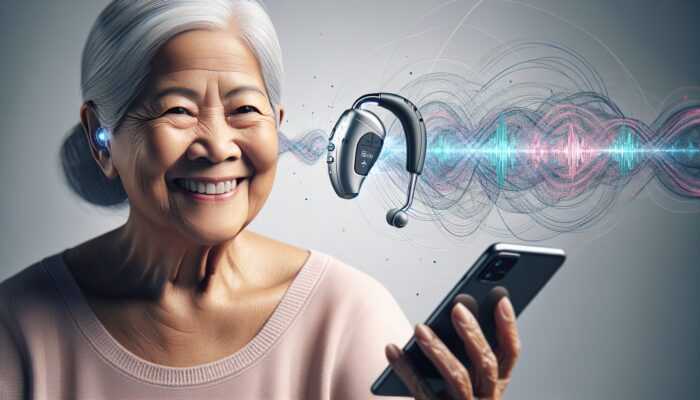Comprehensive Guide to Hearing Aids: Enhancing Your Auditory Experience
What Are Hearing Aids and How Do They Work?

Hearing aids are advanced electronic devices specifically designed to amplify sound for individuals experiencing hearing loss. These remarkable devices significantly enhance users’ ability to hear and communicate effectively, ultimately improving their overall quality of life. By bridging the gap between the sounds of the world and the listener’s auditory capacity, hearing aids play a pivotal role in social interactions. The technology behind hearing aids has evolved remarkably, leading to a variety of types that cater to diverse hearing needs and preferences. Here’s a comprehensive list of common types of hearing aids:
- Behind-the-ear (BTE) hearing aids
- In-the-ear (ITE) hearing aids
- In-the-canal (ITC) hearing aids
- Completely-in-canal (CIC) hearing aids
- Receiver-in-canal (RIC) hearing aids
- Bone-anchored hearing systems (BAHA)
- Rechargeable hearing aids
- Bluetooth-enabled hearing aids
These diverse options provide users around the globe with the flexibility and choice they need, allowing for a customized auditory experience tailored to individual needs and lifestyles.
How Do Hearing Aids Function to Improve Sound Perception?
The operational mechanism of hearing aids is intricate yet fascinating. Hearing aids work by capturing sound through a built-in microphone that collects auditory signals from the surrounding environment. This sound is then transformed into digital signals, which are processed by the device. Once processed, the amplified signals are sent to the user’s ear via a speaker, facilitating clearer hearing and improved communication. The conversion of sound into digital data allows for sophisticated manipulation of sound frequencies, enabling users to easily discern speech, especially in noisy settings.
The technology behind these devices has advanced significantly, incorporating features that not only amplify sound but also enhance speech clarity. The processing typically employs sophisticated algorithms designed to differentiate among various sounds, which proves particularly advantageous in bustling environments, whether in a crowded café in Paris or amidst a lively family gathering in Tokyo.
Essential Components of Hearing Aids That Enhance Auditory Experience
A hearing aid is composed of several key components that work together seamlessly to provide an optimal auditory experience. The essential components include:
- Microphone: Captures sound from the environment.
- Amplifier: Increases the strength of the sound signals.
- Speaker: Delivers the amplified sound to the ear.
- Battery: Powers the device, which can be either disposable or rechargeable.
- Receiver: Converts electrical signals back into sound waves.
Each of these components plays a critical role in the overall functionality of hearing aids, ensuring that users can enjoy enhanced sound quality. For example, the sensitivity of the microphone can significantly influence how well the hearing aid performs in different sound environments, making it crucial for users to select a model that aligns with their unique lifestyle.
Discover the Benefits of Using Hearing Aids

The advantages of using hearing aids extend far beyond mere sound amplification; they significantly enrich users’ quality of life. Enhanced communication is perhaps the most apparent benefit, as hearing aids empower individuals to engage in conversations with greater ease. This improvement not only encourages social interaction but also mitigates feelings of loneliness and isolation that can arise from hearing difficulties.
Moreover, hearing aids play a vital role in supporting mental health by facilitating auditory engagement, which is essential for cognitive function. Improved hearing can lead to positive outcomes in various aspects of life, from actively participating in social events to enjoying cultural activities like concerts and theatrical performances. In essence, hearing aids not only enhance the auditory experience but also contribute to a more fulfilled and connected life.
Exploring the Science of Noise Reduction in Hearing Aids
What Is Noise Reduction Technology and Its Importance?
Noise reduction technology in hearing aids is specifically designed to filter out background noise, enabling users to concentrate on speech and other significant sounds in their environment. This technology is especially crucial for individuals who find themselves in diverse soundscapes, from bustling city streets to tranquil cafés. Various types of noise reduction technologies exist, each tailored for different auditory challenges:
- Adaptive noise reduction
- Multi-channel noise reduction
- Feedback cancellation systems
- Wind noise reduction algorithms
- Dynamic range compression
- Sound localization features
- Frequency-specific noise filtering
- Automatic adjustments based on environment
This advanced technology significantly improves the effectiveness of hearing aids, particularly in noisy settings, making conversations clearer and more enjoyable for users.
How Does Directional Microphone Technology Enhance Hearing?

Directional microphones are a crucial feature in contemporary hearing aids, designed to focus on sounds coming from the front while diminishing noise from other directions. This directional capability allows users to hone in on conversations, especially in challenging environments where background noise can be overwhelming. The effectiveness of these microphones lies in their capacity to distinguish between different sounds, prioritizing speech frequencies over ambient noise.
In practical applications, users benefit immensely from directional microphones in various settings, such as during meetings or social gatherings. For instance, someone attending a wedding reception can engage in meaningful conversations with friends while minimizing distractions from background music or chatter. This feature empowers users to fully participate in their social lives, leading to a more connected and fulfilling experience.
The Critical Role of Digital Signal Processing in Hearing Aids
Digital signal processing (DSP) is the foundation of many advanced hearing aids available today. This technology encompasses a range of techniques designed to analyze and modify sound signals in real time. DSP enhances speech intelligibility while simultaneously reducing unwanted background noise, creating a clearer auditory environment for users.
By utilizing complex algorithms, DSP can identify specific sound patterns and adjust frequencies to ensure that essential auditory cues are prioritized. For example, if a user is in a crowded area, DSP can amplify speech sounds while suppressing noise from other conversations or environmental sounds. This capability not only facilitates better communication but also significantly enriches the user experience, making it easier to engage in conversations regardless of surrounding conditions.
Expert Recommendations on Enhancing Speech Clarity in Noise with Hearing Aids
What Do Audiologists Suggest for Optimal Hearing Aid Usage?
Audiologists recommend several strategies to ensure that hearing aids operate effectively, particularly in noisy environments. Regular maintenance is vital, as it helps sustain the device’s functionality and prolong its lifespan. Audiologists often recommend scheduling consistent follow-ups to adjust settings based on user experiences and varying environments. For example, an audiologist might suggest fine-tuning hearing aid settings after a user reports difficulties in understanding speech at a bustling restaurant.
In addition to technical adjustments, audiologists stress the importance of user education. Many users are unaware of the various features available in their devices, such as noise reduction settings or directional microphones. By gaining a better understanding of how to utilize these features effectively, users can significantly enhance their experience in noisy settings, ultimately leading to a more satisfying auditory experience.
How Can Users Maximize the Performance of Their Hearing Aids?
Maximizing the performance of hearing aids involves several practical steps that users can easily implement. First and foremost, ensuring a proper fit is essential; poorly fitted hearing aids can result in sound leakage or discomfort, detracting from the overall listening experience. Users should also prioritize regular cleaning to prevent earwax buildup and debris that can impair performance.
Moreover, understanding how to adjust the settings based on different environments can greatly enhance the utility of hearing aids. For example, in quieter settings, users may prefer an open setting for a more natural sound, while in noisy environments, activating noise reduction features can be beneficial. Additionally, users should maintain regular communication with their audiologists to receive personalized advice tailored to their specific needs. This proactive approach fosters better hearing experiences across various settings, from serene parks to bustling marketplaces.
How Does the Environment Affect Hearing Aid Functionality?
The environment plays a significant role in how effectively hearing aids function, directly impacting users’ experiences. Factors such as background noise levels, acoustics, and even the physical layout of spaces can influence sound quality and clarity. In a bustling urban environment, for example, high levels of ambient noise can challenge even the most advanced hearing aids, making it essential for users to understand their device’s capabilities.
For users who frequently navigate various settings, it is crucial to adapt their hearing aids accordingly. Many modern devices come equipped with adaptive features that automatically adjust settings based on the user’s surroundings. However, users should also be proactive in recognizing when they need to make manual adjustments, such as switching to a directional microphone in crowded spaces or increasing amplification in quieter environments. By staying attuned to their surroundings and responsive to their hearing aids, users can significantly enhance their auditory experiences in diverse locations.
How Do Hearing Aids Improve Speech Clarity in Noisy Environments?
What Features Are Key to Enhancing Speech Clarity?
Numerous features integrated into modern hearing aids significantly contribute to enhancing speech clarity, making communication smoother and more effective for users. Among these features, frequency compression and speech enhancement algorithms stand out as crucial components. Frequency compression shifts higher frequency sounds to lower frequencies where users may have better hearing capabilities, ensuring that essential speech cues are not overlooked.
Additionally, speech enhancement algorithms prioritize speech frequencies over background sounds, making conversations clearer and more intelligible even in challenging acoustic environments. For instance, in a noisy café or a lively party, these features work in tandem to amplify the subtle nuances of human speech while attenuating distractions from the surrounding noise. Users who leverage these features often report a more satisfying and connected conversational experience, enabling them to engage more fully with their surroundings.
Understanding the Importance of Frequency Compression
Frequency compression serves as a vital tool in enhancing speech clarity for hearing aid users. This technology is particularly advantageous for individuals with high-frequency hearing loss, where the ability to perceive certain sounds, such as consonants, is diminished. By shifting high-frequency sounds to lower frequencies, frequency compression allows users to hear these critical sounds more distinctly, significantly aiding in speech understanding.
In practical terms, this means that users can better differentiate between similar-sounding words and phrases, making conversations more intelligible. For example, someone using a hearing aid with frequency compression may find it easier to understand a friend discussing plans over the background noise of a busy street, as the essential sounds of speech are brought into the frequency range where their hearing is more acute. This feature enhances users’ ability to engage in conversations across various settings, leading to increased social interaction and confidence.
How Do Speech Enhancement Algorithms Operate?
Speech enhancement algorithms are designed to intelligently process sound waves, ensuring that important speech frequencies are prioritized over other sounds. These algorithms analyze incoming sound signals, effectively distinguishing between speech and noise. By doing so, they enhance conversation quality, especially in environments where multiple sounds compete for attention.
In practical terms, this means that when users are situated in settings like bustling restaurants or crowded public spaces, these algorithms assist in filtering out distracting noises while amplifying the sounds of nearby voices. This technology profoundly impacts users’ ability to communicate effectively, enabling them to engage with family, friends, and colleagues without straining to hear over background noise. Consequently, users often find increased satisfaction in social settings, leading to more enjoyable interactions and a greater sense of community engagement.
Technological Advancements Transforming Hearing Aids
What Are the Latest Innovations in Hearing Aid Technology?
The realm of hearing aid technology is continuously evolving, with recent innovations significantly enhancing user experiences. Among the latest advancements are AI-driven sound processing capabilities, which enable hearing aids to adapt in real time to users’ auditory environments. This innovative technology allows devices to analyze soundscapes and make instant adjustments, providing a personalized listening experience that was previously unimaginable.
Additionally, wireless connectivity enables hearing aids to connect seamlessly with smartphones, televisions, and other devices, greatly enhancing functionality and convenience. Users can stream music, take phone calls, or even adjust their hearing aids through intuitive smartphone apps. Furthermore, advancements in battery technology, such as rechargeable options, have simplified device maintenance by eliminating the need for frequent battery changes. These innovations not only improve the functionality of hearing aids but also ensure that users enjoy a more enjoyable and integrated auditory experience.
The Role of Artificial Intelligence in Revolutionizing Hearing Aids
Artificial Intelligence (AI) is playing an increasingly significant role in the development of modern hearing aids. By leveraging machine learning algorithms, AI can analyze users’ listening habits and preferences, allowing for a customized auditory experience. This technology enables hearing aids to learn from their environments, adjusting settings automatically based on the sounds present, such as distinguishing between a quiet home environment and a noisy outdoor café.
Moreover, AI-driven features can enhance speech recognition and clarity, significantly improving users’ ability to engage in conversations in varied settings. As AI continues to advance, we can expect hearing aids to become even more adept at personalizing sound experiences, making them more user-friendly and efficient. The integration of AI not only enhances the auditory experience but also promotes greater independence and confidence for users in their daily lives.
Exploring Wireless Connectivity and Its Advantages
The advent of wireless connectivity in hearing aids has transformed the user experience, offering numerous benefits that cater to contemporary lifestyles. Wireless technology allows hearing aids to connect with a variety of devices, including smartphones, tablets, and televisions, enabling users to stream audio directly to their hearing aids. This seamless integration enhances usability, making it easier for users to enjoy music, take phone calls, and watch television without the need for additional accessories.
Additionally, wireless connectivity often includes smartphone apps that allow users to control their hearing aids directly from their devices. This feature enables easy adjustments to settings based on different environments, enhancing the overall listening experience. For example, users can quickly switch between modes for a quiet library setting and a lively social gathering with just a few taps on their smartphones. Overall, wireless connectivity fosters a more integrated and convenient auditory experience, empowering users to engage with the world around them more effectively.
Research-Backed Benefits of Hearing Aids in Noisy Environments
How Do Studies Validate the Effectiveness of Hearing Aids in Noisy Settings?
Research consistently demonstrates that hearing aids significantly improve speech understanding in noisy environments. Users of hearing aids often report enhanced communication experiences, particularly in challenging auditory settings. For instance, studies reveal that individuals wearing hearing aids are better able to engage in conversations amidst background noise, leading to increased social interaction and engagement.
Expert analysis of these findings underscores the importance of hearing aids in facilitating clearer communication across varying environments. Users experience not only improved sound quality but also a heightened sense of confidence when participating in social situations. This is particularly vital in diverse global settings, such as navigating busy marketplaces or joining community events, where effective communication is essential for fostering connections and relationships.
What Long-Term Advantages Have Been Identified Through Hearing Aid Use?
Long-term use of hearing aids has been linked to numerous benefits beyond improved hearing. Research indicates that consistent hearing aid usage can lead to enhanced cognitive function and increased social engagement. Individuals who use hearing aids are often more inclined to participate actively in conversations and social activities, contributing to better mental health outcomes and a reduced risk of cognitive decline.
As users become more involved in their communities and maintain social relationships, they experience an overall improvement in their quality of life. This active engagement is crucial in diverse cultural contexts, where social interaction plays a pivotal role in individual well-being. By facilitating communication, hearing aids empower users to lead more fulfilling and connected lives.
Exploring the Psychological Impact of Enhanced Hearing
The psychological effects of improved hearing through the use of hearing aids are profound. Enhanced auditory experiences can significantly reduce feelings of isolation and frustration commonly associated with hearing loss. Users frequently report increased confidence in social settings, allowing them to engage more freely with family and friends without the stress of missing out on conversations.
Moreover, improved hearing can foster a greater sense of independence and empowerment. Users who can hear clearly are more likely to participate in activities they previously avoided, such as attending social events or joining community groups. This enhanced participation nurtures a sense of belonging and connection, which is vital for overall psychological well-being. The ripple effect of these improvements can significantly elevate users’ quality of life, illustrating the powerful impact that hearing aids can have.
How Do Hearing Aids Improve Clarity of Speech in Noisy Environments?
Hearing aids employ advanced technologies such as directional microphones and noise reduction algorithms to enhance speech clarity in noisy surroundings. By concentrating on speech sounds while minimizing background noise, these devices enable users to engage in conversations more effectively. The integration of these technologies is crucial for users who frequently navigate bustling environments, allowing them to communicate comfortably amidst distractions.
For example, in a crowded restaurant, hearing aids can amplify the sounds of nearby conversations while attenuating the clatter of dishes or background music. This capability not only improves speech clarity but also enhances social engagement, allowing users to enjoy their experiences without feeling overwhelmed by noise. As a result, hearing aids play a vital role in enriching the overall auditory experience, making daily interactions smoother and more enjoyable.
What Are the Immediate Benefits of Hearing Aids on Speech Perception?
Users often experience immediate and noticeable improvements in speech perception when utilizing hearing aids in noisy settings. This enhancement allows for better understanding and engagement in conversations, significantly enriching social interactions. The ability to differentiate between speech and background noise provides users with the confidence to participate actively in discussions, whether in intimate gatherings or larger social events.
For instance, someone attending a family reunion may find it easier to join in on conversations, enjoying the company of loved ones without straining to hear. This immediate improvement not only boosts confidence but also encourages ongoing social participation, reinforcing the importance of hearing aids in enhancing quality of life. Enhanced speech perception fosters a sense of connection and belonging, showcasing the transformative impact these devices can have on everyday experiences.
How Can Users Effectively Adapt to Noisy Environments?
What Strategies Can Users Employ in Noisy Settings?
Navigating noisy environments can be challenging for individuals using hearing aids, but implementing effective strategies can significantly enhance their listening experience. One key strategy involves positioning oneself to face the speaker, as this allows for better sound directionality and clarity. Additionally, utilizing visual cues, such as maintaining eye contact and observing facial expressions, can support auditory information processing.
Here’s a bullet list of practical tips for users:
- Position yourself to face the speaker directly.
- Reduce background noise when possible by opting for quieter settings.
- Utilize visual cues, such as lip reading, to aid comprehension.
- Ask for clarification if speech is unclear.
- Take breaks in noisy environments to prevent auditory fatigue.
- Employ directional microphones to focus on specific sounds.
- Practice active listening techniques to enhance engagement.
- Experiment with different hearing aid settings for various situations.
By employing these strategies, users can significantly improve their auditory experiences, fostering better communication and social interactions even in bustling settings.
The Significance of Lip Reading and Visual Cues in Communication
Lip reading and visual cues play a crucial role in enhancing understanding, especially in noisy environments where auditory signals may be compromised. For individuals with hearing loss, supplementary visual information can enrich their ability to comprehend spoken language, allowing for more effective communication.
By focusing on the speaker’s lip movements, facial expressions, and gestures, users can gain additional context and meaning, thereby enriching their understanding of conversations. This is particularly beneficial during social gatherings, where background noise may hinder auditory clarity. Encouraging users to engage in eye contact and be aware of visual cues can foster a more interactive and fulfilling communication experience. Integrating these practices into daily interactions can help users navigate challenging auditory environments more smoothly.
Utilizing Assistive Listening Devices for Enhanced Communication
Assistive listening devices (ALDs), such as FM systems, can be invaluable tools for hearing aid users, particularly in noisy environments. These devices enhance sound clarity by transmitting audio directly to the user’s hearing aids, minimizing background noise interference. For example, in a classroom setting or during presentations, ALDs can allow speakers’ voices to be heard clearly, significantly improving comprehension.
Users can benefit from utilizing ALDs in various contexts, including lectures, social gatherings, or even one-on-one conversations in busy places. By combining hearing aids with ALDs, individuals can create a more tailored auditory experience, ensuring they can engage fully with their environment. This integration enhances communication and social participation, empowering users to navigate diverse auditory landscapes more effectively.
Practicing Active Listening Techniques for Better Engagement
Active listening is essential for effective communication in any environment, involving full concentration on the speaker and processing information accurately. Users can enhance their comprehension by asking for clarification when needed and summarizing what has been said to ensure understanding. This technique is particularly beneficial in noisy settings, where distractions may hinder auditory processing.
To practice active listening, users should focus on the speaker, maintain eye contact, and provide verbal affirmations to indicate engagement. Additionally, they can take notes or ask questions to clarify points of confusion. These techniques foster a deeper connection between the speaker and listener, enhancing the overall quality of interactions. By adopting active listening strategies, users can significantly improve their communication experiences, even in challenging auditory environments.
Essential Maintenance and Care for Hearing Aids
How Frequently Should Hearing Aids Be Cleaned?
Regular cleaning of hearing aids is imperative for maintaining optimal performance and prolonging their lifespan. Ideally, users should clean their devices daily to prevent the buildup of earwax and debris that can impair sound quality. Simple cleaning routines can effectively keep hearing aids in peak condition, ensuring reliable functionality.
Users can employ various cleaning methods based on their device type. For instance, wiping the outer casing with a soft, dry cloth can eliminate dust and oils, while using a soft brush can help clear debris from microphones and speakers. Additionally, utilizing specialized cleaning kits designed for hearing aids can further enhance cleanliness and performance. By committing to a consistent cleaning routine, users can ensure their hearing aids remain effective tools for communication.
Best Practices for Storing and Handling Hearing Aids
Proper storage and handling of hearing aids are crucial for their longevity and effectiveness. Users should store their devices in a dry, cool place, preferably in a protective case to prevent damage. Additionally, handling hearing aids with clean hands can minimize the transfer of dirt and oils, contributing to their maintenance.
When not in use, users should consider removing batteries or placing the device in a dehumidifier to prevent moisture buildup. These precautions are particularly important in humid climates where moisture can adversely affect electronic components. By following proper storage and handling techniques, users can prolong the life of their hearing aids, ensuring they remain reliable companions for years to come.
When Is It Necessary to Seek Professional Maintenance?
While regular care and maintenance can prevent many issues, users should be mindful of when to seek professional assistance with their hearing aids. If individuals notice any changes in sound quality, such as distortion or muffled sounds, it may indicate a need for professional maintenance. Additionally, if the device is not functioning as expected, seeking help from an audiologist or hearing care professional is advisable.
Professional maintenance can involve cleaning, repairs, or adjustments to settings to optimize performance. Users should also consider scheduling routine check-ups to assess the overall condition of their hearing aids, ensuring they receive timely interventions if needed. By maintaining an open line of communication with hearing care professionals, users can avoid potential issues and ensure their devices function effectively.
Future Innovations and Trends in Hearing Aid Technology
What Exciting Developments Can We Anticipate in Future Hearing Aids?
The future of hearing aid technology promises thrilling advancements that will further elevate user experiences. Innovations are expected to focus on making devices more discreet while enhancing functionality and connectivity. As technology continues to evolve, we can anticipate hearing aids that seamlessly integrate into daily life, offering users unprecedented convenience and auditory clarity.
Future designs may also introduce features such as enhanced AI-driven sound processing capabilities that adapt to users’ environments in real time. These improvements will likely prioritize user comfort and satisfaction, allowing for a more natural listening experience. As research and development progress, hearing aids will become even more user-friendly, catering to the diverse needs of individuals worldwide.
The Promise of Fully Implantable Hearing Aids
The concept of fully implantable hearing aids signifies a groundbreaking advancement in auditory technology. By eliminating the need for external devices and batteries, these implants offer a seamless solution for users, providing a discreet and effective means of enhancing hearing. As this technology progresses, it could revolutionize the way individuals experiencing hearing loss engage with sound.
Fully implantable systems have the potential to deliver consistent sound quality and eliminate concerns related to maintenance and external device management. As research continues to advance in this area, we can expect significant developments that will make these implants a viable option for a broader range of users, ultimately enhancing accessibility to effective hearing solutions.
How Will AI Continue to Influence Hearing Aid Development?
The role of artificial intelligence (AI) in hearing aid development is poised to expand, driving innovation and personalization. AI’s capacity for real-time sound analysis and adaptive features will likely enhance the performance of hearing aids, making them more effective and user-friendly. As AI technology evolves, hearing aids will be able to learn from user preferences and listening habits, allowing for tailored auditory experiences in diverse environments.
Furthermore, AI could facilitate advancements in remote monitoring and adjustments, enabling hearing care professionals to provide support without requiring users to visit clinics frequently. This capability will enhance accessibility and convenience, allowing users to maintain optimal hearing experiences effortlessly. As AI continues to shape the future of hearing aids, users can look forward to increasingly sophisticated devices that enhance communication and improve overall quality of life.
Frequently Asked Questions About Hearing Aids
What are hearing aids and their primary function?
Hearing aids are electronic devices that amplify sound for individuals with hearing loss, improving their ability to communicate effectively and engage in social interactions.
How do hearing aids operate and enhance sound perception?
Hearing aids capture sound through a microphone, convert it into digital signals, and amplify it for the user’s ear via a speaker, enhancing overall hearing capabilities.
What types of hearing aids are currently available?
Common types of hearing aids include behind-the-ear (BTE), in-the-ear (ITE), and completely-in-canal (CIC) models, among others, catering to various preferences and needs.
What is the significance of noise reduction technology in hearing aids?
Noise reduction technology filters out background noise to help users focus on speech, thereby enhancing communication in noisy environments.
How does directional microphone technology contribute to improved hearing?
Directional microphones focus on sounds from the front, reducing noise from other directions and enhancing speech clarity in noisy settings, facilitating better communication.
What maintenance practices are necessary for hearing aids?
Hearing aids should be cleaned regularly, stored properly, and checked by a professional for maintenance and adjustments when necessary to ensure optimal performance.
How can users maximize the performance of their hearing aids?
Users can maximize performance by ensuring a proper fit, regularly cleaning their devices, and using appropriate settings for different environments to enhance their auditory experience.
What are the psychological benefits associated with using hearing aids?
Using hearing aids can reduce feelings of isolation, improve social engagement, and enhance overall mental well-being by facilitating better communication and interactions.
What future innovations can we expect in hearing aids?
Future innovations in hearing aids may include fully implantable devices, advanced AI capabilities, and increased wireless connectivity for enhanced user experiences and convenience.
How can users adapt effectively to noisy environments?
Users can adapt by facing speakers, utilizing visual cues, and employing assistive listening devices to improve communication clarity in noisy settings.
Explore our world on X!
The post Hearing Aids: Enhancing Speech Clarity in Noisy Environments appeared first on The Microsuction Ear Wax Removal Network.






















